Hanna Kay - Intra-actions*
Exhibition @ the Tamworth Regional Gallery
April - May 2022
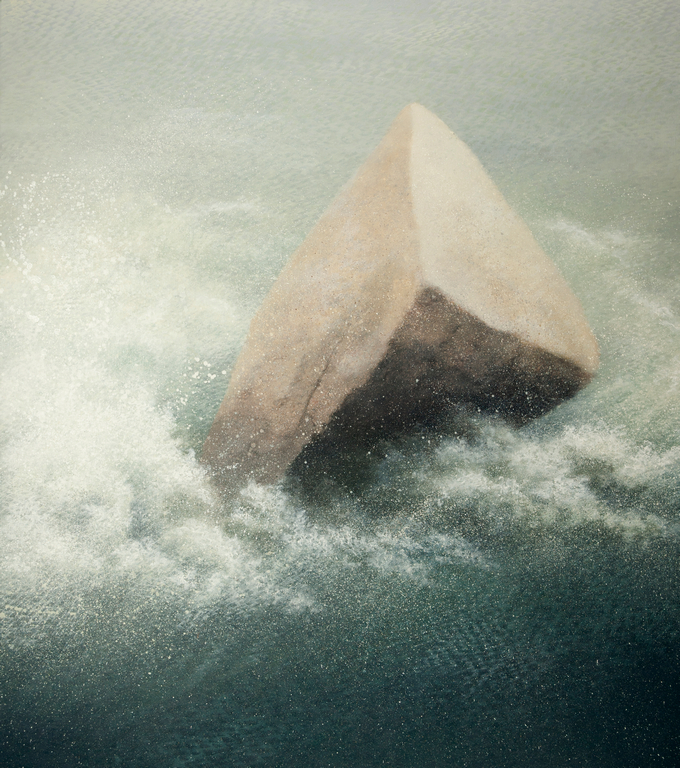
Impact 2 2012, oil and tempera on linen 155x140cm
My artworks draw on the immediate natural surroundings in which I live. They are a record of memories and experiences. I don't document – I prefer to imagine and follow urges and sparks of intuitive ideas. Mostly my art is an aesthetic expression of the reciprocal relationship between humans and nature. I entitled the exhibition Intra-actions to highlight this aspect of our relationship with the natural world and to emphasise that the ability to interact emerges from within the relationship rather than enforced from outside of it. And that this ability is in flux, and changing according to processes it is engaged in.
I have been painting and drawing for over four decades in four continents where I was fortunate enough to establish myself as an artist. The trajectory of my artistic career has taken me from Israel, where I grew up, to Europe where I studied art in Vienna, to New York where I lived and practised my art for a decade, to Sydney for a decade, and finally to the Upper Hunter valley where my home and studio are situated amid five acres, cradled between a river and the ranges which provide an endless source of inspiration.
Perhaps because I moved between cultures and languages, my way of connecting to a place, and making sense of it has been through the natural environment and it has served me as a point of reference when settling into a new place. In time I have come to recognize that the landscape and the forces that act upon it are the most important factors that shape a society's practices and an essential element in the formation of a culture’s distinctiveness. This conviction has been a driving force and a stimulus. The art I end up making explores the tension between order and disorder, between what-is and what-was. They offer the viewer a dialogue between states of being and can be seen as instances of cycles connected to natural processes of growth, decay, and regeneration.
Breeze [dry / wet] 2021
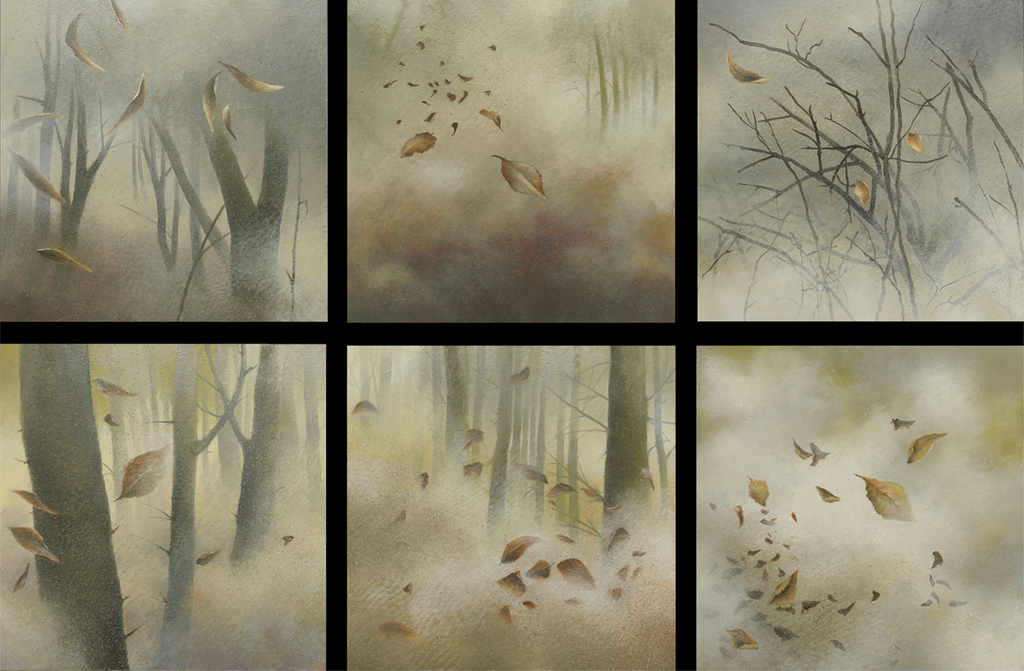
Breeze [dry] oil and tempera on linen, 6 canvases each 66x66
My intentions when making Breeze were to express visually the contrast of a life swaying between droughts and wets. Between silence and silence.
In a drought the silence is loud. Birds and insects take their song to greener pastures.
In Summer the sun is blinding and the air heavy and still.
in Winter diluted light and thinner air render the day naked. The silence is even louder.
When it is wet, I can feel the silence skirts around the day, waiting for water to subside. And its absence is deafening.
Thus I follow my inner compass toward an aesthetic of silence. With regular, almost zigzagging movements, I create thin layers of oil paint. I use the brush as if it was a light breeze moving the colours on the surface of the canvas, making surfaces that reflect shimmering yet silent surroundings.
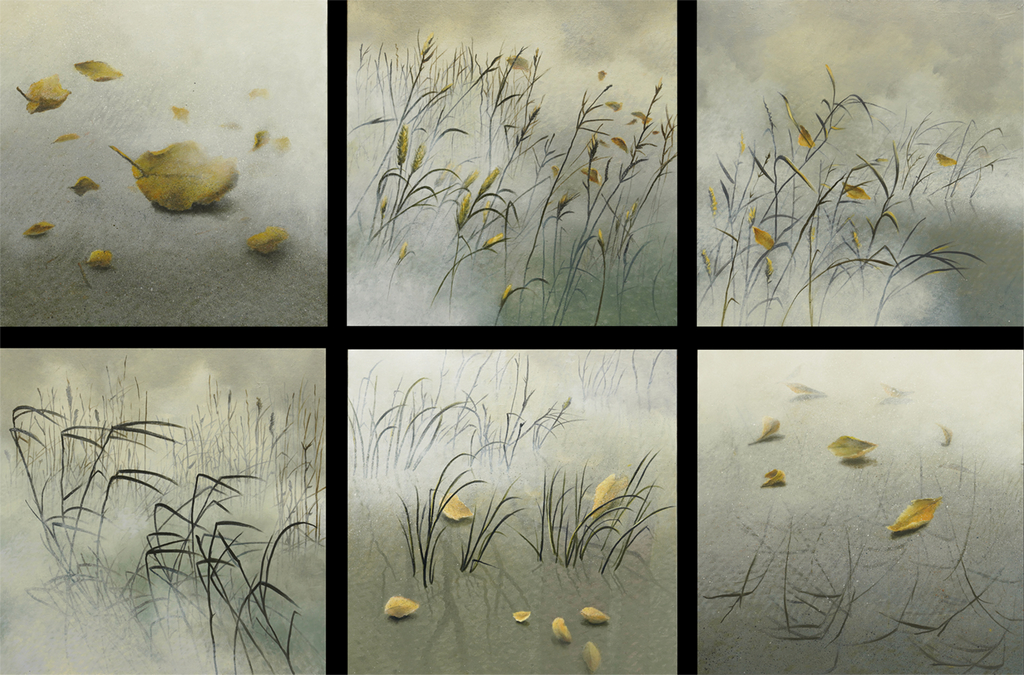
Breeze [wet] oil and tempera on linen, 6 canvases each 66x66
Into the Woods 2019 - 20
.jpg)
oils and tempera on rice paper, 21 panels each 140 x 70cm [installation detail]
In this site-specific installation, I wish to draw the viewer into the forest, into an aesthetic of silence. The series, comprising of 21 compositions on Chinese rice paper, offers the viewer a pictorial journey that unfolds from lightness to darkness and back to light and aspires to underpin the forest as a network of communication.
In some panels the presence of natural forces, such as dust, fog and mist, renders the forest as an intimate ambiguity. In other instances, distinct parts of the landscape, such as mountains and grasses provide a more discernible context. Although I draw on the immediate natural setting in which I live, there is no attempt to replicate here a particular vista. Rather the painted fragments of forests depict personal remembered experiences in the landscape.
When painting I draw on the techniques used by European renaissance masters, which I studied in Vienna. Thus, the surface of the Chinese papers is an outcome of layering of oil paint and tempera washes, splattering and rhythmic squiggly brushstrokes that are visible traces of labour-intensive painting activity. As such the artworks steer the viewer towards a multitude of issues ranging from a dialogue with art history and its gesture to a continuum to highlighting cross-cultural issues and their consequences for the natural environment.
Video pan of the work @ https://vimeo.com/435614758
Shibboleth Series (2017-18)
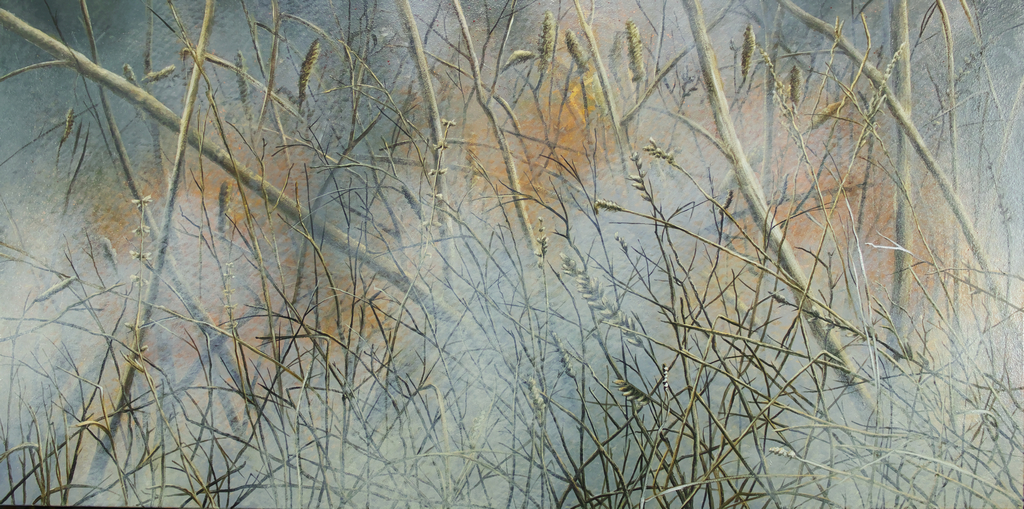
Shibboleth: R oil and tempera on linen 100 x 200cm
My daily walks are framed by fields of feral grasses and weeds stretching from one side, where the trees edge the riverbank, to the other side, reaching the slopes of the ranges. In some seasons, the dew on the tall weeping stalks will glitter in the rising sun, while the setting evening sun will catch the tips of motionless grasses turning the fields bronze. At other times the grasses are short, either frostbitten or drought thirsty
The term "shibboleth", is taken from my native language Hebrew, and it means ‘ear of grain’. For me, in addition to personal memories of singing odes to the harvest of the land, and glorious images of golden fields of wheat swaying in the breeze, it evokes the Biblical myth of a massacre of members of one tribe by their brothers - the legend tells that after their defeat by the Gileadites, the Ephraimites tried to escape across the Jordan River. Stationed next to the banks of the river, the Gileadites would ask each person attempting to cross to say the word ‘shibboleth’. The Ephraimites, who were unable to enunciate ‘sh’ sounds, would say ‘shibboleth’, thus revealing their identity. The Gileadites slaughtered 42,000 members of the Ephraim tribe.
Historically, the word was used as a pronunciation test to identify the ‘other’. These days the word has a wide range of common meanings. According to the Merriam-Webster dictionary, ‘shibboleth’ is 1) an old idea, opinion, or saying that is commonly believed and repeated but that may be seen as old-fashioned or untrue; 2) a word or way of speaking or behaving which shows that a person belongs to a particular group. In the artwork I intended to draw attention to the arbitrariness of definitions, in particular when it comes to our treatment of the environment and its people, be it refugees on the other side of the world, or migrants and neighbours and their ‘otherness’, that disturbs our equilibrium.
Experiences of the peculiarity of the ‘other’ does not always have to do with pain and intrusions. Nature, as the landscape presents, is just another way of meeting that which is different to us. Whether inspiring or threatening the working of nature's forces is inscribed on rocks, trees, deserts, and mountains. These aspects of the natural environment are portrayed in the artworks, and evoke nature’s own cycles as marked by the seasons and Aeolian processes. The presence of unforgiving natural forces that may at any moment act, for better or worse, upon any place is depicted in each of the artworks. They are a reminder that is oblivious to us and our social and cultural constructions. The paintings are personal, remembered encounters in the landscape and an attempt to highlight the tension between human transiency and the resilience of the natural environment.
in flux series
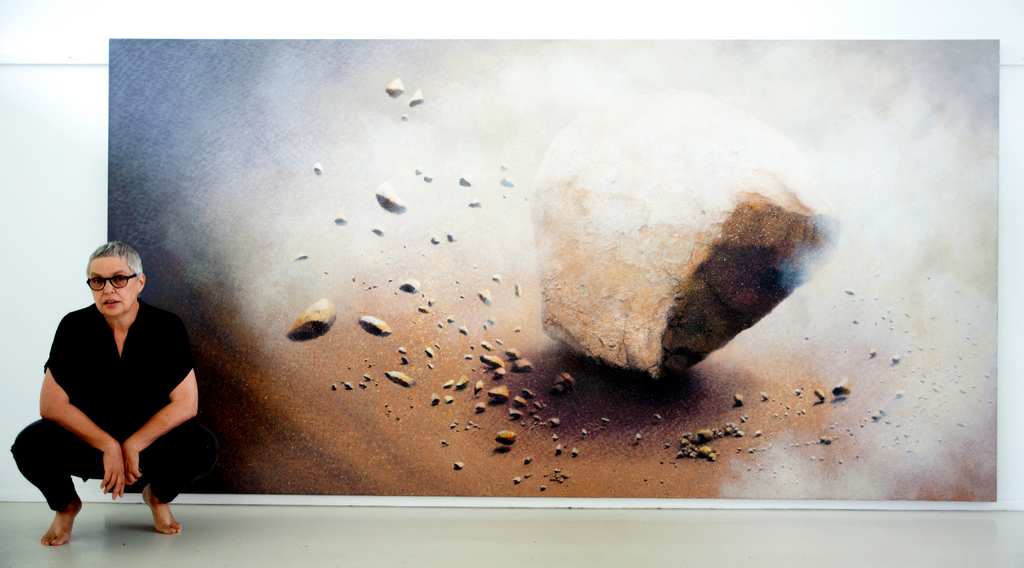
Impact 2012, oil and tempera on linen 180x350cm
An arid landscape looms high in my personal and cultural memories. On one hand, violent campaigns and tribal feuds have been fought over a minute expanse of desert terrain. On the other hand - a serene place of meditation and contemplation.
in flux – gimel, oil on paper
The desert is both silent and noisy - the silence of solitude and the noise of sand being made. The weather turns large rocks into smaller stones, and then into pebbles, and then into sand. Outer surfaces become sand grains that in time will turn back into sandstones. Such circularity is widespread. Ocean waves pound rocks, shattering them into stones, then to gravel and finally to sand. The wind carries the grains of sand inland. Making sand dunes where the wind will bang sand grains into one another making dust. And so on.
* Intra-action is a term coined by the physicist and philosopher Karen Barad. I came across her ideas in the course of my academic research and realised that they suit my thinking of what it means to be entangled in today’s world in general, and in particular, for my practice as an artist. In her book Meeting the Universe Halfway, she replaces ‘interaction’ with the term Intra-action. In brief, it suggests that ‘doings’ or ‘actions’ are not the property of an individual to be employed upon a ‘thing’, but rather a manifestation of forces in which all ‘things‘ participate with each other - constantly exchanging and influencing and working inseparably.
When It comes to my art I chose to use this term to highlight the sense that we, as humans, do not hold a privileged position over the environment with which we interact. This subtle shift in perspective provides an understanding of how as ethical individuals we participate in a world that unfolds as we connect, communicate and act within it.